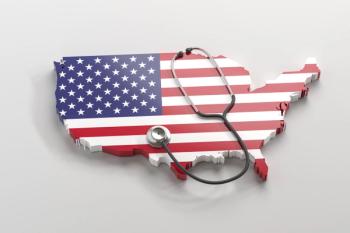
Budesonide-Based Triple Therapy Shows Best Benefit Over Dual Therapy for COPD
The triple therapy of budesonide, glycopyrrolate, and formoterol fumarate showed the greatest incremental net benefit among a series of triple therapy medications that were evaluated against dual therapy for chronic obstructive pulmonary disease (COPD), according to an analysis presented at ISPOR.
The triple therapy of budesonide, glycopyrrolate and formoterol fumarate (B/G/F), which is marketed as Breztri Aerosphere (AstraZeneca), showed the greatest incremental net benefit among a series of triple therapy medications that were evaluated against dual therapy for chronic obstructive pulmonary disease (COPD).1
The results were presented this week at
In COPD, dual bronchodilator therapy consists of a long-acting muscarinic antagonist (LAMA) and a long-acting β2-agonist (LABA). In recent years, there is evidence that adding an inhaled corticosteroid (ICS) can improve the effectiveness of the LAMA/LABA combination, but
Thomas et al, in their presentation at ISPOR 2024, stated that they “pooled the incremental net benefits of QALYs [quality-adjusted life years] and exacerbations of triple therapy compared with dual therapy in COPD.” Investigators selected modeling to address the heterogeneity seen. Out of 116 studies, 10 were eligible for the analysis.
When comparing triple therapy with dual therapy in COPD, the incremental net benefit of QALYs across all medications (all in US dollars) was $4969.19 (95% CI, $3620–$6318.21); which investigators said indicated a “substantial degree of heterogeneity.” A subgroup analysis showed the following:1
- B/G/F showed an incremental net benefit of $5717.96
- Fluticasone furoate/umeclidinium/vilanterol (FF/UMEC/VI), sold as Trelegy Ellipta, had an incremental net benefit of $5675.90
- Tiotropium/fluticasone/salmeterol (TFS) showed a slightly negative incremental net benefit
- For exacerbations, the pooled incremental net benefit was $21,163.81 (95% CI $4788.62–$37539.00). B/G/F was found to have the highest positive incremental net benefit of $45,540.51; FF/UMEC/VI had $14,832.51 and TFS had $10,249.29.
Although cost-effectiveness analyses have been used for years by payers in evaluating the relative value of newer therapies, these types of studies are expected to gain importance as CMS evaluates therapeutic alternatives under the Inflation Reduction Act (IRA), which received considerable attention at this year’s meeting. In addition, real-world
“The meta-analysis results reveal the cost-effectiveness of triple therapy, particularly B/G/F in comparison to dual therapy concerning both QALYs and exacerbations,” Thomas et al wrote. “However, the substantial heterogeneity underscores the imperative for additional research and comprehensive insights in this domain.”1
Data Show Budesonide/Formoterol Is Cost-Effective for Youth in China
A separate poster at ISPOR 2024 presented real-world data that showed the dual therapy budesonide/formoterol (B/F) plus an as-needed short-acting ß2-agonist (SABA) can be a cost-effective treatment for pediatric patients 6 to 12 years of age in China, compared with salmeterol/fluticasone.3
Although the analysis found that B/F, sold as Symbicort, can be slightly more expensive than salmeterol/fluticasone, sold as Advair HFA and other brands, B/F offered superior clinical benefits, according to authors from several institutions in Shanghai and Guangzhou in China.
They found that over a 3-year time horizon, the dual therapy B/F led to a slightly higher total cost of ¥551.96 (US $76.37) with QALY gains of 0.0025. Compared with salmeterol/fluticasone as a maintenance therapy, B/F as maintenance contributed to significantly better outcomes:
- B/F reduced by 69.07% the likelihood of hospitalization events (0.006 vs 0.0194 events, respectively),
- B/F reduced the probability of outpatient events by 15.87% (2.184 vs 2.596 events, respectively)
- B/F reduced hospitalization costs by ¥80.81 (US $11.18) per person and reduced outpatient expenses by ¥103.54 (US $14.33) per person.
“The base case incremental cost-effectiveness ratio was ¥221,593.464 [US $30,661.04] per QALY gained, lower than a willingness-to-pay of ¥257,904 [US $35,685.19]/QALY,” which the authors said was 3 times China’s gross domestic product-per-capita. “According to sensitivity analyses, the model was the most sensitive to the prescription drug price,” they wrote.
References
- Thomas C, Varghese V, Raj K, Undela K. Cost-effectiveness of triple therapy compared to dual therapy in patients with chronic obstructive pulmonary disease: a systematic review and meta-analysis. Value in Health. 2024;27(6):S1,Poster 7017
- Cazzola M, Rogliani P, Laitano R, Calzetta L, Matera MG. Beyond dual bronchodilation—triple therapy, when and why. Int J Chron Obstruct Pulmon Dis. 2022; 17: 165–180. doi:10.2147/COPD.S345263
- Zuo C, Jiang Y, Zhou K, Xie X, Xuan J. The cost consequence of budesonide/formoterol plus as-needed SABA as treatment for 6-12 year old pediatric asthma patients in China based on real-world data. Value in Health. 2024;27(6):S1,Poster 3002.
Newsletter
Stay ahead of policy, cost, and value—subscribe to AJMC for expert insights at the intersection of clinical care and health economics.

















































